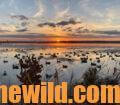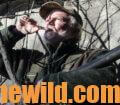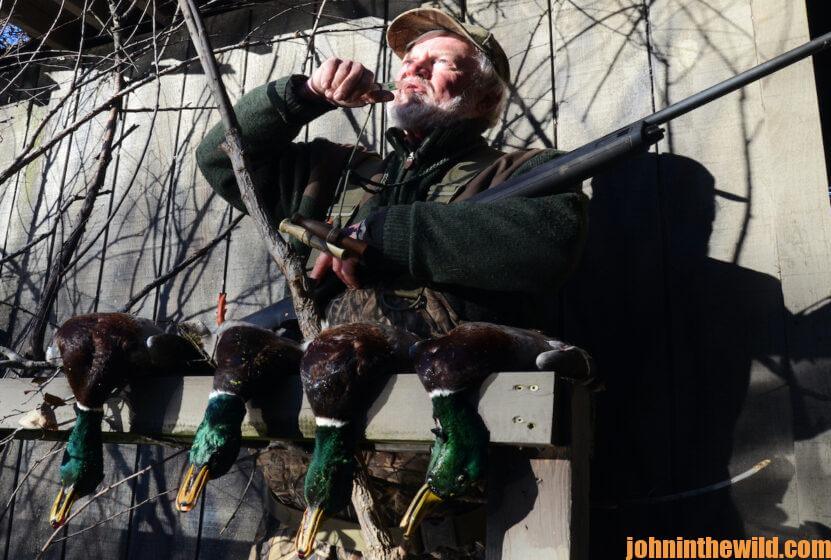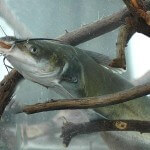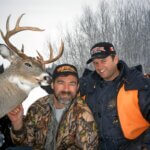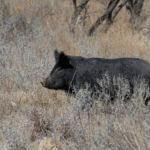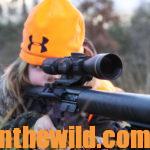Editor’s Note: Steve McCadams, 67 years old, from Paris, Tennessee, has been guiding duck hunters for 47 years. “I hunt Kentucky Lake on the Tennessee River, and I’ve got a flooded farm on the Obion River Swamp that I hunt in northwest Tennessee. When I’m hunting Kentucky Lake, that’s what we call, ‘big water hunting.’ We’re hunting backwaters off the main Tennessee River where there are mudflats, islands and sloughs. In open water, we put out fairly-big decoy spreads – usually 350-400 decoys. We take a variety of ducks on these hunts, including ringnecks, goldeneyes, buffleheads, bluebills – all diver ducks. We’ll put a few of those kind of decoys on one end of the decoy spread, but then the bulk of my spread is made up of gadwalls and mallard decoys with a few wigeons. Although we don’t take a lot of geese like we did in the 1970s, 1980s and 1990s, we’ll still put out 30-40 Canada floater decoys in the spread and some coots. Several years ago when these areas had a lot of aquatic grass, I put out more coot decoys than I do today.”
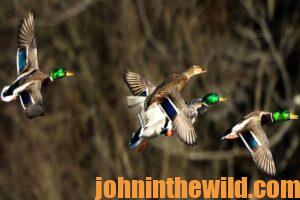 Why Use a Half-Moon Decoy Spread: “I like to use a half-moon decoy spread to put the ducks in the open water right in front of the blind.” McCadams says. But McCadams isn’t afraid to move his decoy spread to better suit the weather and wind conditions on the days he’s hunting. “Some mornings, I’ll put my diver-duck decoys on the downwind side of my decoy spread, instead of having them upwind of the spread. And sometimes, I’ll put more ducks on the downwind side of the spread to cause the ducks to work a little bit better and come in closer to the blind. You don’t want to put your decoys too far outside of the blind, because if you do, the ducks you’re calling may swing wide of the blind or light 100-yards away from you, and your hunters can’t get shots. The way the wind is blowing each day I’m hunting determines how I move the decoy spread, so it better fits the direction from which I expect the ducks to come. On my best morning, when I’ve got good duck weather and six good shooters, all my hunters may limit out within an hour of legal shooting time. I wish that that happened more often than it does because everybody in the blind gets really excited when they limit-out that fast. However, those are rare days because the ducks are moving at first light, and often, that’s when you’ll get your best shooting.”
Why Use a Half-Moon Decoy Spread: “I like to use a half-moon decoy spread to put the ducks in the open water right in front of the blind.” McCadams says. But McCadams isn’t afraid to move his decoy spread to better suit the weather and wind conditions on the days he’s hunting. “Some mornings, I’ll put my diver-duck decoys on the downwind side of my decoy spread, instead of having them upwind of the spread. And sometimes, I’ll put more ducks on the downwind side of the spread to cause the ducks to work a little bit better and come in closer to the blind. You don’t want to put your decoys too far outside of the blind, because if you do, the ducks you’re calling may swing wide of the blind or light 100-yards away from you, and your hunters can’t get shots. The way the wind is blowing each day I’m hunting determines how I move the decoy spread, so it better fits the direction from which I expect the ducks to come. On my best morning, when I’ve got good duck weather and six good shooters, all my hunters may limit out within an hour of legal shooting time. I wish that that happened more often than it does because everybody in the blind gets really excited when they limit-out that fast. However, those are rare days because the ducks are moving at first light, and often, that’s when you’ll get your best shooting.”
 How Many Callers in the Blind: Although some duck guides often choose to have other hunters call to the ducks and geese at the same time they do, McCadams does all the calling himself. “Occasionally, I’ll have other hunters help me call to the geese; however, when I’m calling the ducks, I prefer to be the only caller. One of the reasons that some duck hunters don’t take as many ducks as they can is because they call too much to the ducks. I think knowing when not to call to the ducks is as important as understanding when to call to the ducks.”
How Many Callers in the Blind: Although some duck guides often choose to have other hunters call to the ducks and geese at the same time they do, McCadams does all the calling himself. “Occasionally, I’ll have other hunters help me call to the geese; however, when I’m calling the ducks, I prefer to be the only caller. One of the reasons that some duck hunters don’t take as many ducks as they can is because they call too much to the ducks. I think knowing when not to call to the ducks is as important as understanding when to call to the ducks.”
 Most any veteran duck hunter will tell you that when calling ducks, experience is the best teacher. The more experience the caller has at calling ducks, the more likely he is to pull those ducks out of the sky and into the decoys with their feet down and their wings cupped. “On a quiet day, when there’s not much wind, you have to be very easy with your calling, and calling less is often more,” McCadams emphasizes. “Many duck hunters call too much on those kinds of days and can’t understand why they can’t get the ducks to come into the decoy spread. The real secret to calling ducks is to be able to pick out the subtleties in the ducks’ reactions in the air – once they hear you call. If you’ve got the experience, you know when to call and when to be quiet and just let your decoys do the job of bringing the ducks into the decoy spread. On a quiet day with little or no wind, the ducks will be very skittish. But on a windy day, you often can blow your duck call until you squeeze the trigger on your shotgun. Sometimes on a windy day, you really have to stay on your duck call to keep the ducks’ attention and keep them coming to your decoy spread.
Most any veteran duck hunter will tell you that when calling ducks, experience is the best teacher. The more experience the caller has at calling ducks, the more likely he is to pull those ducks out of the sky and into the decoys with their feet down and their wings cupped. “On a quiet day, when there’s not much wind, you have to be very easy with your calling, and calling less is often more,” McCadams emphasizes. “Many duck hunters call too much on those kinds of days and can’t understand why they can’t get the ducks to come into the decoy spread. The real secret to calling ducks is to be able to pick out the subtleties in the ducks’ reactions in the air – once they hear you call. If you’ve got the experience, you know when to call and when to be quiet and just let your decoys do the job of bringing the ducks into the decoy spread. On a quiet day with little or no wind, the ducks will be very skittish. But on a windy day, you often can blow your duck call until you squeeze the trigger on your shotgun. Sometimes on a windy day, you really have to stay on your duck call to keep the ducks’ attention and keep them coming to your decoy spread.
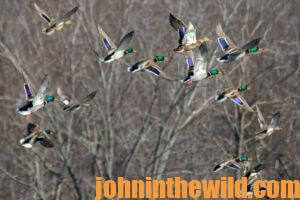 “Another thing that determines success or failure when you’re calling ducks is to know what species you’re talking to. Mallards and other big ducks often respond better to your calling than smaller ducks do. Gadwalls and pintails may be very finicky and won’t take much calling. So, the best thing to do is to hunt with an experienced caller, watch what he does and when he does it, and see what’s successful in getting the ducks to come down. Then repeat what you’ve learned the next time you go duck hunting. Really and truly, ducks will teach you more about when to call and when not to call than any other way you can learn these skills. You’ve just got to see how the ducks react to your calling and to your decoy spread.”
“Another thing that determines success or failure when you’re calling ducks is to know what species you’re talking to. Mallards and other big ducks often respond better to your calling than smaller ducks do. Gadwalls and pintails may be very finicky and won’t take much calling. So, the best thing to do is to hunt with an experienced caller, watch what he does and when he does it, and see what’s successful in getting the ducks to come down. Then repeat what you’ve learned the next time you go duck hunting. Really and truly, ducks will teach you more about when to call and when not to call than any other way you can learn these skills. You’ve just got to see how the ducks react to your calling and to your decoy spread.”
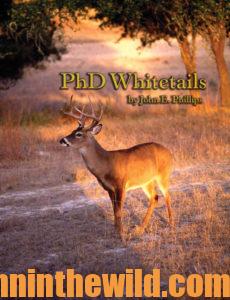 To hunt with Steve McCadams you can call him at 731-676-7748; his email address is [email protected], or visit him at his Facebook page https://www.facebook.com/steve.mccadams.
To hunt with Steve McCadams you can call him at 731-676-7748; his email address is [email protected], or visit him at his Facebook page https://www.facebook.com/steve.mccadams.
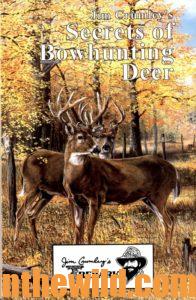 For more information about John E. Phillips’ hunting books, visit www.amazon.com/author/johnephillips. To learn more about hunting deer, check out John E. Phillips’ book, “PhD Whitetails: How to Hunt and Take the Smartest Deer on Any Property,” available in Kindle and print at http://amzn.to/WIEUoo and Audible at https://www.audible.com/. To learn more about hunting for deer, check out John E. Phillips’ “Jim Crumley’s Secrets of Bowhunting Deer”, now available as of January 1, 2022 in Audible, as well as paperback and Kindle at https://www.amazon.com/. You may have to copy and paste this link into your browser. (When you click on this book, notice on the left where Amazon says you can read 10% of the book for free, and you can hear 10% for free). On the right side of the page and below the offer for a free Audible trial, you can click on Buy the Audible book. Go to https://www.amazon.com/ to learn about John and Denise Phillips’ cookbook, available in Kindle and print, “The Best Wild Game and Seafood Cookbook” that includes an entire chapter on bird recipes, including recipes for their favorite duck dishes.
For more information about John E. Phillips’ hunting books, visit www.amazon.com/author/johnephillips. To learn more about hunting deer, check out John E. Phillips’ book, “PhD Whitetails: How to Hunt and Take the Smartest Deer on Any Property,” available in Kindle and print at http://amzn.to/WIEUoo and Audible at https://www.audible.com/. To learn more about hunting for deer, check out John E. Phillips’ “Jim Crumley’s Secrets of Bowhunting Deer”, now available as of January 1, 2022 in Audible, as well as paperback and Kindle at https://www.amazon.com/. You may have to copy and paste this link into your browser. (When you click on this book, notice on the left where Amazon says you can read 10% of the book for free, and you can hear 10% for free). On the right side of the page and below the offer for a free Audible trial, you can click on Buy the Audible book. Go to https://www.amazon.com/ to learn about John and Denise Phillips’ cookbook, available in Kindle and print, “The Best Wild Game and Seafood Cookbook” that includes an entire chapter on bird recipes, including recipes for their favorite duck dishes.
Tomorrow: Steve McCadams’ Duck Hunting Equipment & More Methods

